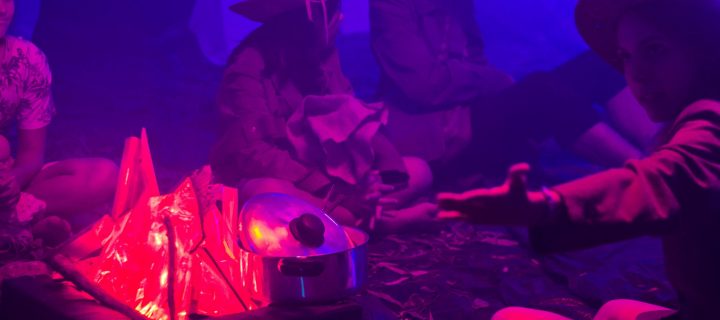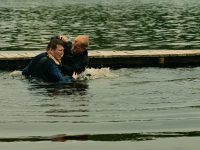Editorial note: This article was originally published in the Knutepunkt 2025 book Anatomy of Larp Thoughts, a breathing corpus. It has been reprinted from there with the editors’ and authors’ permission. It has not been edited by Nordiclarp.org.
“Daddy, tell me a story? But not that scary one!”
My father kindly let my brothers and I lie down on his bed in the space between him and my mother. He liked to start by telling a short story about how things were in his and his father’s time, and then continue with the terrifying stories that we supposedly didn’t want to hear. All of them were told as if they were real stories, events that had actually taken place many years ago somewhere in the interior of São Paulo – and they usually involved fantastic creatures that stealthily tried to deceive the living and take their souls to the afterlife.
This was part of my early childhood. It is known that the tradition of oral storytelling is one of the oldest and most powerful forms of cultural transmission, but curiously, until much later in my adult life, I had never realized how much this had manifested itself within my own history, and not only in what we learned in books.
The years passed, and my father became harder and more bitter due to the traumas, fears and frustrations of life, and I followed my own distinct paths in life, trying not just to survive, but to find my place in the world. And these paths led me to a peculiar way of telling and experiencing stories, larp!
“Father, I tell stories!”
I don’t think he ever really understood what I was doing. Nor had I been able to see any kind of connection between my larp-making and listening to these stories when I was little.
I had already spent about fifteen years doing larp. To be more precise, it happened in October 2015, a week before the opening of a larp of the group I am part of, and my father had to be rushed to the hospital. I took turns with my brothers to accompany him during his stay in the hospital.
I remember most of all the day before he was discharged from the hospital. He was excited because he was going home soon, so he had put aside some of the bitterness of life. We talked a lot and I had the opportunity to talk a lot about what I had done in the larps.
And at some point in the night I felt like I could ask again: “Dad, tell me those stories you used to tell when we were little?”
And he told me not only one of the chilling stories, but also a new one, one that I didn’t know – or didn’t remember. And it was the best one of all! I listened intently, not just to each word, but to the way he told it, the dramatic pauses, the intonation of the words, the rhythm of the speech and the plot of the story.
My father recovered and at that time he was able to return home.
As for me, I went to the place where the larp would take place. And now I had a new story in my head, one that carried a lot of meaning. I had reconnected with my father. And on top of that, I had received a very valuable gift, one of those that cannot be bought.

Self-portrait of the author and his father
My father was discharged on Thursday and the larp had its first session on Saturday.
It was a larp about national folklore. The theme spoke directly to the stories my father told. So I suggested to my partners in organizing the larp that I tell the story my father had taught me as part of the game’s immersion. But it ended up being much more than that, for that session and for all the following ones.
The two forms of storytelling connected, perhaps in an encounter like the moment my father and I had. I began to tell the story as a character who, around the campfire, enchanted the participants just as parents enchant their children on unpretentious evenings, awakening their capacity to imagine. By the end of the story, all the characters had already been transported directly into the game setting and were experiencing the larp. Of course, the work on scenography, sound and the larp text itself also supported this immersion.
The various stories of Brazilian folklore have already been portrayed in many books, films and plays, but there are many of them that have no record other than oral transmission that passes from generation to generation.
The larp in question was “A Peleja dos Vivos na Noite dos Mortos” (The Fight of the Living on the Night of the Dead), in which the characters gather, in the 1920s, and camp in search of protection to survive the night of the dead, when the dead and other entities from beyond are said to walk among the living.
And the stories my father told me had this same aspect, of fantastic beings walking among the living, testing them.
“Guys, I’m going to tell you a chilling story.”
By immersing the players and telling the newly learned story, I was able to express the oral tradition in the larp and enrich the experience, not only calibrating the game’s expectations, but also adding drama and resources for the characters’ interactions.

Photo by Thomaz Barbeiro, from larp A Peleja dos Vivos, na Noite dos Mortos, by larp group Confraria das Ideias (Sesc Bauru, 2018)
After that moment, my father lived for another eight years, but his stories will live forever as long as someone tells them, whether around a campfire or during a larp.
Oh, and what story did my father tell me? It’s a scary story with lots of twists and turns, but if you want to hear it, you will need to be lucky enough to find a storyteller who knows it in the interior of the State of São Paulo, or go and play this larp with the Confraria das Ideias, at some time and some place, because that is the tradition!
Cover image: photo by Thomaz Barbeiro, from larp A Peleja dos Vivos, na Noite dos Mortos, by larp group Confraria das Ideias (Sesc Bauru, 2018).






